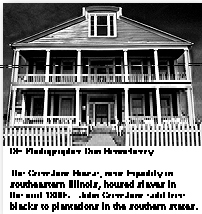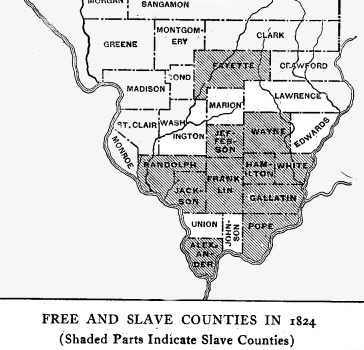|
IN MY RESEARCH TO FIND INFORMATION ABOUT WILLIAM M. HARGRAVE WHO MARRIED CYNTHIA ANN FLANDERS I CAME UPON
A POSTING WHICH SAID IN PART THAT HARGRAVE HAD BOUGHT THE "OLD SLAVE HOUSE" ON HICKORY HILL......I started snooping
and this is what I found!
Built in 1834-38, on the top of high Hickory Hill, on highway 13, about 14 miles east of Harrisburg, near the town of Equality,
Illinois, Hickory Hill Mansion overlooks the Saline River.
Address The Old Slave House Museum, Highway 13, Junction, Illinois 62954. Harrisburg is located at the most southernmost
tip of Illinois.
Description
Hickory Hill Mansion was not only designed to be the dream home of John Crenshaw, his wife, Sinia Taylor and their five
children, it was also built with an evil purpose in mind; to house an illegal slave trade and establish a breeding program.
The outside of the mansion was designed in a "pseudo-Greek revival style," having both upper and lower verandahs, all which
was supported by massive columns, spreading the width of the mansion. The first two floors had six rooms each, where the Crenshaw
family enjoyed a life of privilege, and looked on as model citizens of their community. The attic, just above the family's
living quarters had thickened walls, and consisted of 12 tiny rooms, not much bigger than horse stalls, and a hallway with
two whipping posts.
History
John Hart Crenshaw got his start in running a salt refinery, started by his father, who died when John was in his teens.
By 1834 he had made a small fortune. Because he now had money to invest, John was able to lease several salt springs from
the government and also applied to be authorized to lease slaves from their owners, as it was an old, established, legal practice
in Illinois. Back In 1817, because it was getting harder and harder to hire laborers, Illinois, a slave-free state, had given
employers permission to lease slaves from their owners in slave territory, and bring them to Illinois to work in businesses
suffering from labor shortages, such as salt mining.
But why spend money leasing slaves, when you could kidnap freed blacks in Illinois/elsewhere? Why not "breed" your own
slaves and sell them on the southern market? With these evil ideas in mind, John had a carriageway built that entered directly
into his new mansion. By 1838, when the house was finished, Carriages full of slaves/ kidnap victims could be driven right
into the mansion, and secretly hustled up the back stairway to the infamous attic; a place of imprisonment, suffering, rape,
birth and death. It is said that at least 300 babies were produced from the efforts of one sire slave alone! Pregnant slaves,
or a slave woman with a child brought a high price in the slave states. Crenshaw found the Saline River to be a very convenient
way to transport his cargo to and from the slave states interested in his business. Slaves were shackled to the floor of their
stall-like rooms. Ventilation was poor, and there was little light. They had to endure indignities, torture, bad treatment
and a doomed existence.
In 1842, John was arrested, and accused of selling into slavery a family of freed blacks, who owed him services. Because
of his financial and political standing in the community, he was found not guilty. His mill was burned, though, as public
sentiment turned against him. No one found out what had gone on in the attic until after John and his wife died, in (1871
& 1881). John Crenshaw was considered the most evil man who ever lived in Illinois. What he did to make money was the
largest scandal in Illinois' history.
Note: Although Illinois was constitutionally a free state, slaves worked on Crenshaw's 30,000 acres,
his own private empire. There had been a labor shortage at about the time Illinois became a state, so the state constitution
had a provision to allow slaves on the saline land it leased. Crenshaw leased slaves from Kentucky. In 1830, he leased
746 slaves.
One anecdote of the Crenshaw House is that at one time, he beat some female slaves. The beating must have been especially
brutal, because some of the male slaves rose up against their master and hacked one of his legs off. Later pictures of Crenshaw
with his wife show him with a crutch across his lap.
In 1996, the Sisks closed the museum because they could no longer keep the mansion museum open. Thus began the long battle
to get the state interested in buying the property as a part of Illinois history, though the place has an infamous history.
Although the Illinois Historic Preservation Agency finally acquired the house in December 2000, the site remained closed to
the public, due to lack of state funding to hire staff. On June 9, 2003, between 40 and 50 residents from more than seven
counties met at Southeastern Illinois College and adopted a Plan of Action that could reopen the site. ~
HICKORY HILL Cemetery
Crenshaw, John Hart 1797, wife Sina (Taylor) 1799, Alexander 1829son of J.& S. Crenshaw
Nancy 1824-1826 dau of J.& S. Crenshaw, Mary M. 1844dau of William J. & A.L. Crenshaw
Crenshaw, William 1774-1814 wife Mary 1767(dau of John Hart, Rev. soldier & a signer of Declaration of
Independence.)
HICKORY HILL Cemetery located 3/8 mile SW of crossroads of State Routes #13 and #1.
In Equality Twp. Section 14, T9S R8E. in the lower SE part of the section. On a hill overlooking State Route #1. This is
near the old "Slave House" owned by the Crenshaws during the 1800's. It is believed to be the oldest cemetery in the county
that is recorded.
Gen. Michael K. Lawler
Gen. Michael K. Lawler, was born in County Kildare, Ireland, Nov. 16, 18l4. Michael K. Lawler grew to
manhood in Gallatin County. On Dec. 20, 1837, he was united in marriage to Miss Elizabeth, daughter of John and Sina Crenshaw,
old residents of the County. When the Mexican war broke out M. K. Lawler was bookkeeper for his father-in-law.
He gave up his position, organized a company, of which he wag elected captain, and was immediately sent to the front. At Cerro
Gordo the company distinguished itself, and from that time until the close of the war was in several of the fiercest engagements.
After the war Captain Lawler took up the occupation of farming which he followed until the conimencement of the Civil war.
Then the old military spirit revived and he organized the Eighteenth Illinois volunteer infantry, afterward known as the "Bloody
Eighteenth," of which he was commissioned colonel. The regiment was in many of the hottest engagements of the war, particularly
in Tennessee, Alabama and Mississippi. At Fort Donelson Colonel Lawler was severely wounded in the arm, but after a short
time rejoined his command and remained in the field until the end. On April 15, 1863, he was made brigadier-general by President
Lincoln, and on April 17, 1866, received the rank of brevet major-general from Andrew Johnson. At the close of the war he
was appointed commandant of the post at Baton Rouge, and while there bought a cotton plantation, but soon afterward sold it,
having been appointed to a position as government storekeeper at San Antonio, Tex., where he remained for two years. He then
returned home and lived on his farm until his death, July 26, 1882.
|
 |
|
| The Crenshaw House |

|
| Old Slave House |
Servitude and Emancipation Records, 1722–1863
County: Gallatin, Name of Servant: Charles, Name of Other Party: John Crenshaw,
Husband of Mariah and Father of Nancy Lane, Remarks: Charles is an indentured servant
~
County: Gallatin, Name of servant: Mariah, Name of other party: John Crenshaw Remarks: Wife of Charles & Mother
of Nancy Lane, Mariah is an indentured servant.
~
County; Gallatin, Name of Servant: Nancy Lane Name of Other Party: John Crenshaw, Remarks: Born 10, 1829, Document
Type: Birth, Daughter of Charles & Mariah
~
County: White, Name of Servant: None Given, Name of Other Party: Daniel Crenshaw, Remarks: 1 free person of color

Off Site Link ~ America's Most Haunted Places
Crenshaw Mansion:
At this point in time, the caretaker is the only person allowed up the narrow lane to the house, and it is barricaded
and posted with No Trespassing signs. While there are many people in the county who know the story of the house, and are willing
to talk about it, it has been extremely difficult to obtain pictures of the house. One of the most prominent researchers on
the topic, Jon Musgrave, has also written several articles about the house, and recently published a book titled "Slaves,
Salt, Sex, and Mr. Crenshaw". If you are interested in purchasing the book, go to his website, Ilinois History.com, or Visit
Barnes & Noble or order the book from Amazon.com.........
Cave in Rock:
Cave-in-Rock, located close to the town of the same name, was a perfect place for criminal enterprises
along the river. At that time, it boasted a partially concealed entrance and a wide view up and down the river. The cave is
about one hundred feet deep, with a level floor and a vertical chimney that ascends to the bluff above. Pirates were also
said to have preyed upon ferryboat passengers at Ford’s Ferry, a few miles upriver. The ferryman himself, James Ford,
was said to have been in league with the pirates. He was also said to be one of the “slave catchers” in the employ
of John Hart Crenshaw.
|
 |
|
|
 |
|
|
|

